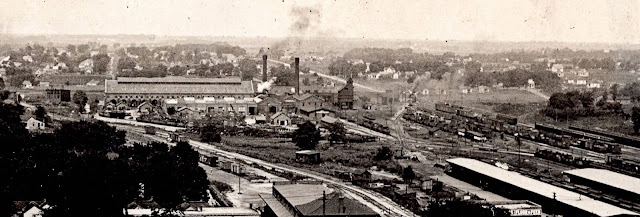K&S = Kankakee & Seneca Railroad
 |
| Kankakee and Seneca Railroad Company posted Here we have a rare photo of the now long gone town of Wauponsee, west of Mazon. In the photo we can see the grain elevator as well as the rarely photographed Wauponsee depot. Also note the boxcar spotted at the elevator for loading. Special thank you to the Grundy County Historical Society for the photo. -Josh Dennis DeBruler shared Soon after the railroad builds a depot and water tower, someone builds a grain elevator. Bob Summers Perhaps the elevator was the first one built if the area was already in crop production? Bob Summers Dennis DeBruler ok, but in southwestern Kansas many farmers came west via the AT&SF mainline west from Hutchinson thru Dodge City and Garden City into Colorado, then homesteaded south and north before the railroads built their branch lines primarily to haul the grain and livestock produced to markets mainly in the east. Bob Summers Most of those branch lines have been abandoned by the railroads since the late 1960's! Dennis DeBruler I didn't realize that homesteading was done so far away from the initial railroads in the West. So elevators were built to motivate a branch line to be built. Bob Summers Probably not before, but the railroads built sidings and leased land for elevators to be built, about every 10 miles in good cropland areas (because in horse drawn wagon days that was about as far as farmers could effficiently haul grain from the farm to an elevator) in order to generate enough business to justify the branchlines. Probably did put in watertowers where water was available, but depots were not the first priority. Actually my great grandfather brought his family from southeastern Iowa to Cimarron in southwestern Kansas in the 1880's to homestead over 20 miles south of Cimarron and set up a general mercantile business in a townsite in the central part of what would become Seward County because the Rock Island RR had surveyed a right of way thru there. Within a couple of years the Rock Island resurveyed and built their line to the Kansas State / Oklahoma Territory line and founded the town of Liberal Kansas. The several merchants that had set up shop relocated and were in Liberal day one. . |
 |
| 1958 Aurora Quadrangle @ 1:250,000 |
 |
| Dennis DeBruler commented on the Kankakee and Seneca Railroad Company post In a 1940 aerial, it appears the town was already disappearing. Does the red rectangle mark where the depot was? |





















































